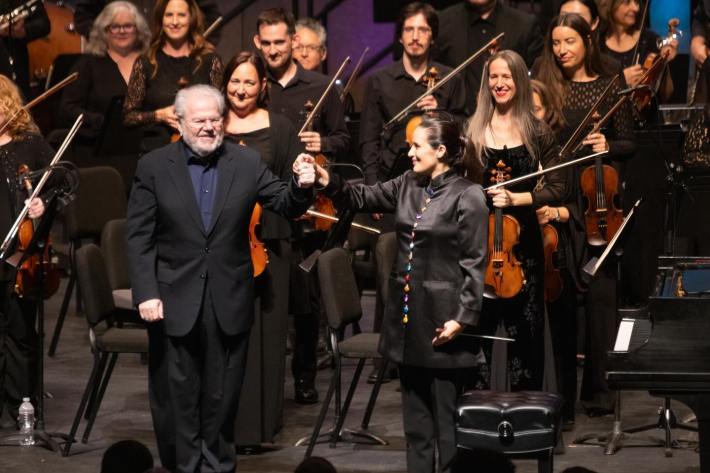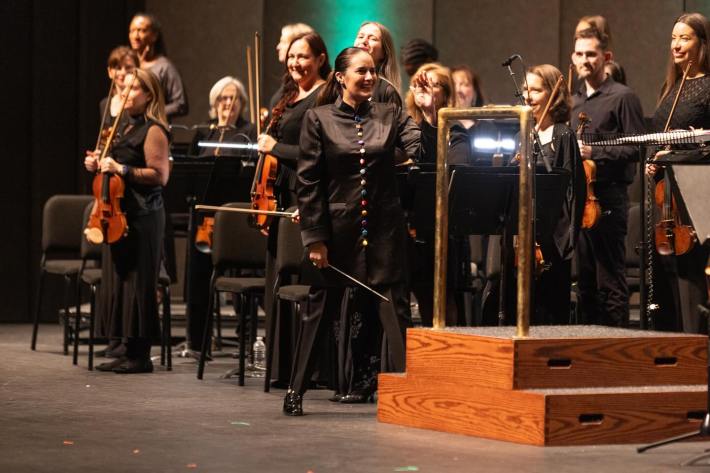Tulsa Symphony Orchestra: 20th Anniversary Concert with Emanuel Ax
Tulsa Performing Arts Center
October 4, 2025
Last Saturday evening’s concert by the Tulsa Symphony Orchestra—a festive celebration of its 20th anniversary season—started a little differently than usual, with two communal moments that bonded the audience with the musicians before a single note was played.
First, TSO Executive Director Ron Predl welcomed us and asked us to acknowledge longtime Tulsa World arts writer James Watts, who was in the audience. The musicians and the crowd rose as one to thank this pillar of the Tulsa arts scene, whose recent termination by the corporate owner of the World is a true loss for our community.
Then Predl announced that the evening would start with a group-sing of “The Star-Spangled Banner.” I was surprised, because classical music concerts don’t usually go there. It’s not a sporting event or a town hall meeting. Besides, I’m a little soured on the whole patriotism/singing/pledging thing lately, what with ICE and banned books and the rise of fascism and whatnot.
But when the evening’s conductor—internationally acclaimed Colombian-American Maestro Lina González-Granados—bounded onstage to enthusiastic applause, and the orchestra rose to their feet with us to play, something softened in my bitter old heart: an immigrant was leading us in our national anthem. With her excellence, her spirit, and her bravery, and her immense talent, she showed us who we are at our best—a country whose heart is big enough both to care for its own and to welcome outsiders, if we’ll only choose to do so. She reminded me of something I forget, these days, that America is bigger than our current shitshow.
Having had my world rocked before the concert proper even started, I sniffled and sat down, ready for some good music. And boy, did I get some. This concert was, in a word, terrific.
Shostakovich’s Festive Overture was the perfect way to open this milestone anniversary season. The brass was absolutely on point in its precision and flare, and the brief piece conveyed the excitement of new beginnings, new possibilities. It was my first time to see Maestro González-Granados conducting; her athletic posture and graceful hands gave the musicians every command they needed.
Next came Beethoven’s Third Piano concerto, featuring the venerable Emanuel Ax, 76 years old and still a delight. I’d never seen Ax in concert, either, though I’ve listened to him my whole life, from my vinyl days to Spotify. His Beethoven was clean, clear, and moving. The man can make the piano sing, both technically and emotionally. At one point, near the end of the first movement’s cadenza, his descending trills sounded like bees hovering over a flower before they landed on the 6/4 chord. The moment made me tear up, which I may have done again during the poignant second movement, its sweetness almost unbearable.

After intermission, the TSO treated us to one of the pillars of classical music, Dvořák’s Ninth Symphony. Dvořák—a Romantic-era Czech composer who toured the U.S. and thereafter incorporated our folk music into his compositions—is a strong influence in the work of American composer John Williams, best known for his film scores. (Williams has also written a concerto for Ax, which premiered at the Tanglewood Festival last summer.) You can really hear the link between the two in the Ninth Symphony’s wide-open-spaces sounds and its ominous, Jaws-like fourth movement. The English horn solo, played by Lauren White, sounded exactly like I want “Goin’ Home” (as it’s popularly known) to sound: homesick and contented at the same time. Rebekah Lorenz, a crowd favorite, broke my heart with her French horn solos, and John Rush and Dana Higbee, trading solos on flute, were absolutely stunning.
Maestro González-Granados was by turns heroic, humble, delicate, and strong. I was astounded at the TSO’s precision and accuracy, and I think it’s because the Maestro used more nuance in her tempos than I have heard from other TSO guest conductors. This required the orchestra to watch her very closely, and they rose to the task. Their entrances, which I have harped on before as being uneven, were precise. Long-held notes were unwavering. Intonation was tight. She demanded more of the TSO than it knew it could give, if my impression from the mezzanine is correct. She made them better, and we are richer for it.

Lest you think I’ve gone too cockeyed-optimist, I do have a couple of quibbles with the evening, neither of which have anything to do with the music.
First, I was perplexed by the program’s reference to the guest conductor as “Lina” in her bio rather than as “Maestro González-Granados,” while referring to Emanuel Ax throughout as “Mr. Ax.” Maybe this was the preference of the artists, but it hit me weirdly. In 2025, it seems like a no-brainer to refer to all the professionals onstage by their title, not their first name.
My second quibble is with the audience itself. You know what I’m talking about. You clapped between movements.
Classical music culture is very particular, it’s true, but we adjust to different cultures in many aspects of our lives. We cheer at football games, but we’re silent during a tennis match. We ululate and fall on the floor at the Church of the Holy Pentecostal Revival Fire, but we kneel on cue at Catholic mass. We wear Daisy Dukes at the taco truck, but put on a skirt for our birthday at Hemingway’s. We can do this, Tulsa!
The no-clapping-between-movements classical music custom is an etiquette thing, sure, but it’s more than that. Not only does between-movements applause destroy the precious moment of silence that our ears need to savor the sounds we just heard, it's also a distraction to the performers. They use the seconds between movements to rest from their labors and prepare for the next movement, whether that be by focusing on their upcoming entrance, adjusting their seating, or turning the page. Mr. Ax was gracious enough to nod at you when you applauded after the first movement, but that doesn’t mean he blessed your indiscretion. He’s a polite guy.
When may you clap, you ask? Here’s a breakdown, using Saturday night’s Dvořák Symphony No. 9 in E minor as an example.
- Movement 1: Adagio: Allegro molto—no clapping, no matter how rousing the final chords were.
- Movement 2: Largo—again, no clapping.
- Movement 3: Molto vivace—I don’t care how much you liked it, don’t clap.
- Movement 4: Allegro con fuoco—this is your cue! Wait until the conductor lowers her baton and turns to face the audience, then go nuts and release all that pent-up emotion.
In other words, when the performer or conductor breaks the fourth wall and turns to lock eyes with the audience, smiling and bowing, that is the moment of consent. That's when the piece is truly finished, when they have presented you with the whole work, in its entirety. Consent is very important.
Good talk.
The TSO is back, breathing fire for its 20th season. Next up: Gustav Holst’s The Planets, plus selections from E.T. and Star Wars by the aforementioned John Williams. I look forward to great things.






